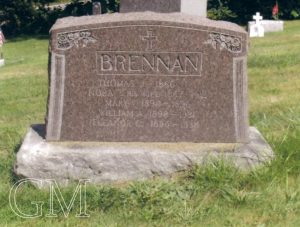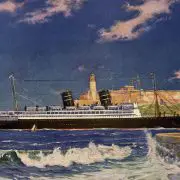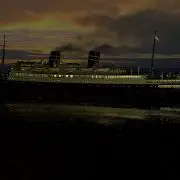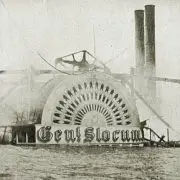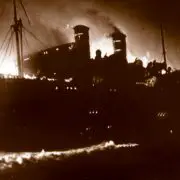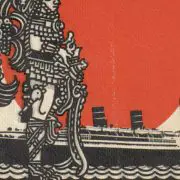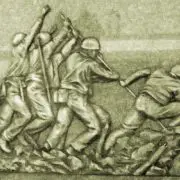Morro Castle, Mohawk and the end of the Ward Line : Part 3
Bones and Ashes
Margaret Saenz, of Havana and New York City, boarded the Morro Castle with her daughters, Caina and Marta, and son Braulio Saenz y Aguilera. They were destined for their New York residence in the Ritz-Carlton Hotel.
None of the Saenz family survived, and the details of what happened to them are a bit cloudy. G.M. Phelps, in his account, describes a Cuban boy suffering from third and fourth degree burns who died in the aft corridor on B Deck. “he was weeping mi madre.mi madre” and cried out ‘”don’t touch me” to his would-be rescuers before dying. This was most likely Braulio Saenz y Aguilera; although a second Cuban boy, Roberto Gonzales, 13, was also lost that night, his body was easily identified at Sea Girt. Margaret Saenz may well have been trapped in her A-Deck cabin- located aft of the lounge well opening, it would have been among the first the fire reached. Steward Charles Wright, and Dolly Davidson, both recalled encountering the badly burned Marta Saenz y Aguilera in the water, wearing a pink night gown and trying to remain afloat; she died while Wright held her upright. Hers was the only body recovered that could be easily identified; Dr. Braulio Saenz eventually chartered a private plane to conduct an aerial search for additional bodies it is possible that none were located. Margaret, Caina and Braulio Saenz-Aguilera appear on the “final” missing list.
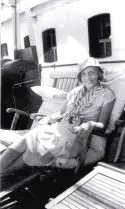
Braulio Saenz y Aguilera was pulled through one of these windows but died aft on B Deck of massive burn injuries more…
On September 14, 1934, a detailed list of bodies recovered from within the ship was made available to the press, which raises more questions than it answers about the fates of the missing members of the Saenz family:
- Skull and chest bones of a man found in passage between Cabins A-19 and A-21.
- Bone fragments of a boy found in Cabin A-21
- Pivot tooth, bone fragments, mass of melted coins, hand mirror found in Suite A-3
- Skull of whippet dog found in cabin A-16
- Bone fragments and bones found in Suite H-N.
- Bone fragments found on Promenade Deck, forward by Captain’s bridge.
- Three coccyx attached to a small piece of the right pelvis; left pelvis; several skull fragments; several rib fragments and a quantity of human ash found in Captain’s cabin.
- A quantity of human ash was found in other locations on the ship.
The remains in Suite A-3 were those of the occupant, Catherine Cochrane, who was known to have been asleep in the suite at the time of the fire. The remains found in ‘Suite H-N’ (which does not appear on any deck plan I have seen) were positively identified as Max ‘Monroe’ Berliner and buried in Queens prior to September14th. The whippet that died in Cabin A-16 was the pet of Mrs. Angela D’Orn, of Havana, who survived. The bone fragments on the promenade deck by the bridge were, to the best of my knowledge, never identified. The remains in the Captain’s Cabin were positively identified as Captain Robert Willmott and buried in Brooklyn. Which leaves the remains found in and near cabin A-21, the Boat Deck cabin once occupied by Margaret and Braulio Saenz Y Aguilera. Braulio was known to have been pulled from the burning cabin through the window, and reliably reported to have died aft on B Deck where he was carried by the crew members who removed him from A-21. Perhaps the fragmentary remains of the ‘boy’ recovered from the room were those of Caina Saenz y Aguilera, and the skull and chest bones of the ‘man’ found in the hallway outside of the cabin were those of Margaret. Several articles published on the 12th mention the body of a boy being found aft on B Deck, and the body of a woman being found forward on the ship lodged in a crevasse where deck plates had bucked. These were most likely Catherine Cochrane who appeared on the list distributed on the 14th, and definitely Braulio Saenz y Aguilera who did not.
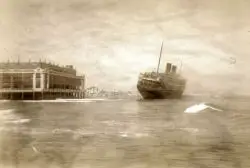
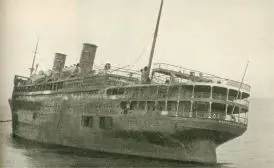
Head Waiter Charles Wright gave this detailed account of his experiences during the disaster, in which he tells of the death of Marta Saenz y Aguilera:
I was asleep when the alarm went off a few minutes after three o’clock. I ran at once to the passengers cabins. The lights of the ship already were failing. I knew some of the passengers by name and that helped me get them out of their cabins and into the passageways.
It was so dark I made them form a chain holding hands. Then the lights went out. A couple of sailors had flashlights and I took one of the passengers by the hand and led the line aft on C Deck.
There were flames and smoke between us and the Boat Deck and I couldn’t get the passengers to go through them to get to the lifeboats amidship. So, we got life preservers and made the passengers put them on. Then we tried to get them to jump, but the deck was over 30 feet above the water and none of them would go over. So we started pushing some of them over and lowering others on ropes. But one old woman got tangled in a rope. She was screaming and Trygue Johnson, a carpenter, climbed down the rope and cut her loose and they both fell into the sea. After that we couldn’t get anyone to go down the lines.
I jumped overboard into the middle of a group of 25 people. We could see the lights on shore- they didn’t seem so far away and that gave us hope.
I saw a little girl, one of the Saenz sisters. She was swimming and I went over and picked her up and put her arms through my lifebelt. Then we saw an elderly woman and we picked her up and she held on to my lifebelt as well.
The three of us kept afloat for about three hours. We picked up a board and that helped. Just about daylight the girl moaned and after that she was quiet and didn’t move. I held on to her for an hour more before I realized she was dead. Other passengers who were in the water around us told me to let the girl go and help someone who was alive, but I didn’t want to. But finally a man and his wife pleaded with me to let the girl go and I did.
Then a girl in a bathing suit and a life preserver came up to us. The girl pointed out the City of Savannah about a mile away. It was nearer than the shore and she suggested that she and I swim to it and get a lifeboat to come back and pick up the others in the water around us. We got to within 500 yards of the ship and then it moved off, away from us. I don’t know how long we were in the water after that before one of the Monarch of Bermuda lifeboats picked us up.
Charles Wright was sparing in his description of the Saenz girl in this written account, but in others he mentioned that she was horribly burned on the face and arms. Several others in the large group of survivors Wright joined spoke of the “badly burned girl in the pink nightgown” who died during the morning hours.
Charles Wright returned to sea and would survive two more shipwreck before January 1935 was over.
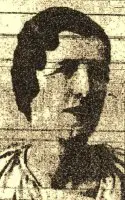 |
| Eleanor Brennan |
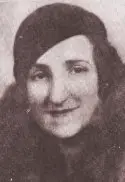 |
| Camilla Conroy |
Camilla Conroy, of Baltimore Maryland, and Eleanor Brennan of New York, probably did not view themselves as ‘symbols’ of anything, but from a contemporary (2006) viewpoint these two women demonstrate just how far things had progressed for women in the 22 years since the loss of the Titanic. Although both were unmarried and were at what would, in 1912, have been referred to as ” the danger age” the two were are far from Susan Weber, (Titanic’s 30-something ‘spinster’ being sent off to work as the housekeeper for a younger relative for lack of better prospects) as it was possible, in 1934, to get. They probably never met, but the two led parallel lives and died equally lonely deaths on September 8 1934.
Eleanor Brennan was born in Carmel New York, in 1898, the oldest daughter of Thomas and Nora Brennan. The family maintained a home in the town of Carmel as well as a farm residence in the rural district of Secor’s Corners. Eleanor, as often happened at the turn of the last century, was forced to leave school and become the primary caretaker of her younger siblings upon the death of her mother in 1912. But, in post World War 1 New York, this did not guarantee a life of drudgery, and as the children came of age. Eleanor took a job in Macy’s in New York City, commuting at first and, as she began to succeed, moving from rural Putnam County to the Bronx. By 1934 she was the head buyer for the Drapery and Curtain Department of the Herald Square flagship store. Although still unmarried, she did not seem to be suffering for it; in 1933 the Knights of Columbus had elected her Society Sweetheart and awarded her a diamond ring, and the fatal voyage was her second Morro Castle cruise for 1934. ‘Spinster’ was not a term which could be applied to Eleanor Brennan.
Camilla Conroy was, in her own way, as independent and successful as Eleanor Brennan. At 38 she was the secretary to State’s Attorney Herbert R. O’Conor, a position she had held for some time. Coworkers would praise her attributes after her death on the Morro Castle and the words “intelligent” and “competent” were most often used in that context. Pictures show Camilla to have been more stylish than conventionally pretty: her clothing was well tailored, up to the minute in terms of style, and from her posture and carriage in the published photos one senses that she was an extremely confident woman. In one way her life was the total opposite of Eleanor Brennan’s: her father had died after an accident, followed shortly thereafter by her mother who died after a sudden disease. When her brother passed away a few years prior to the Morro Castle disaster, Camilla was left as the sole support of her older, unmarried sisters May and Agnes. Eleanor had raised her siblings and then continued with her life, while Camilla had established a life for herself only to find herself the primary caretaker for her siblings in early middle age.
Eleanor was found the morning of the fire, drifting in her life jacket astern of the Morro Castle. Most likely she had died of exposure and exhaustion as did most of the victims: her doctor later related that she was completely unburned. 2000 friends and coworkers attended her wake in the Bronx, overflowing into the street, and an additional 1000 neighbors, old friends, and coworkers attended her Mass at St. James Catholic Church in Carmel. The church, and burial site at St. Lawrence O’Toole Cemetery in Brewster New York were said to be ‘awash’ in flowers as Eleanor, who may have been unmarried but who definitely was not alone, was laid to rest beside her mother.
State’s Attorney O’Conor took it upon himself to travel to New Jersey to find Camilla and spare her sisters the pain of viewing the bodies in the temporary morgues in Sea Girt and Spring Lake. He located her remains, and was able to learn that she had been found floating face down in her nightgown, without a life preserver, in the water beside the ship. This gives a hint to the probable circumstances of Camilla’s last minutes: crew members watching from the bow described how passengers, trapped in their cabins by fire, were jumping head first, rather than feet first, from their portholes and either knocking themselves out against the side of the ship, or stunning themselves upon impact with the water and drifting astern face down.
Agnes and May, her older sisters and the last survivors of what had once been a large family, were informed of the disaster, and Camilla’s death, by neighbors. They were taken to the home of a friend, where the press found them sobbing hysterically and exclaiming over and over “why did she have to go?”
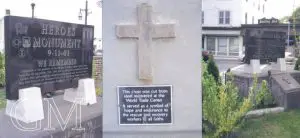
Left: Eleanor’s grave. Right: The Brennan family town home in Carmel NY, occupied in 1934 by Eleanor’s aunt, Mary Lynch, no longer exists. The structure was cleared soon after it hosted Miss Brennan’s wake and replaced by the town’s first Art Deco diner. The diner, in turn, was supplanted by a gas station. The site was converted after September 2001 to a mini-park commemorating local WTC victims.
Francis Stewart, 34, of Riverdale, New York, considered himself fortunate to be aboard the Morro Castle. The cruise to Havana was his first-ever ocean voyage, and his booking was literally last minute. Employed as a civil engineer in the office of the Borough President in Richmond, Stewart had tried repeatedly to obtain passage aboard the ship to coincide with his week long summer vacation, but nothing was available in his price range. He had abandoned the idea of the Havana cruise, when he was notified by phone of a cancellation shortly before departure. He happily took the booking.
His cabin mate, George A. English of Lynbrook, Long Island, New York, was the last to see Francis alive. Like so many others, the two were awakened by the commotion in the hallway outside of their cabin, and English would later tell Stewart’s parents and brother that, when last seen, he was struggling to pull down his life preserver as smoke poured into the cabin and the hallway outside the door began to ignite.
Stewart, who did not know how to swim, died of exposure while awaiting rescue. The first-time voyager who considered himself lucky, was identified at Sea Girt New Jersey by his close friend Leo McConnell.. He was buried in Calvary Cemetery in Queens following a Mass at the Church of the Visitation in Kingsbridge, Bronx, New York.
Charles Graber, of Scarsdale New York, also considered himself extremely fortunate. The New York University student had spent July and August of 1934 working as an elevator attendant aboard the Morro Castle, and had quit after what proved to be the final completed round trip in order to prepare for his sophomore year.
“I finished in the post office Saturday afternoon and went across the street to a store. The radio was going and when they told me it was the Morro Castle, I couldn’t believe it. I knew all those fellows. But, I’m glad my special pal was saved. That was Harry Stamm, telephone operator. He worked in the cabin next to me for six trips. We were great friends.”
Charles Graber’s mother had wanted him to make one final trip before returning to college. “If I’d had my way, he’d have been on the boat Saturday” she said. “I liked the idea of him sailing, but I am certainly glad I did not have my way!”
September 8 th 1934 should have been a day of excitement for bath steward Rene Olavarria of New York City: his wife Dorothy was about to give birth to their child, and had circumstances been different he would likely have been there when Emilia Olavarria (1934- January 2004) was born on September 10th at Metropolitan Hospital in New York Instead, Rene died of exposure and exhaustion, leaving his widow to support her newborn as best she could. His body was identified at Sea Girt, but the news of his death was withheld from Dorothy until she was considered strong enough to handle it.

